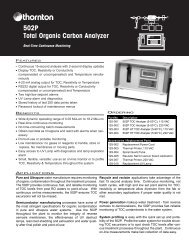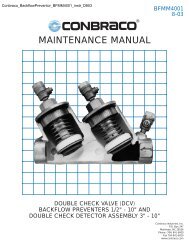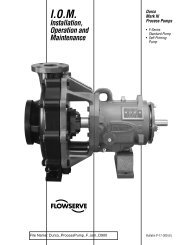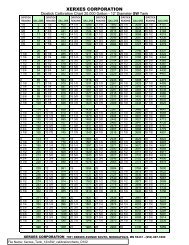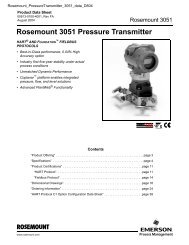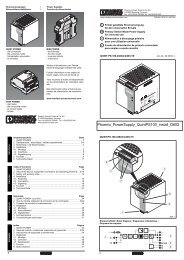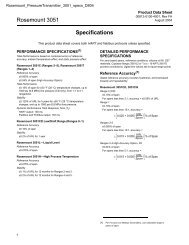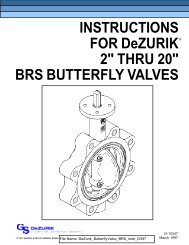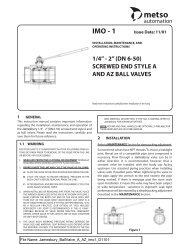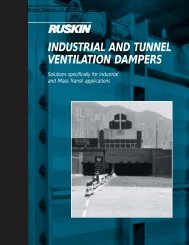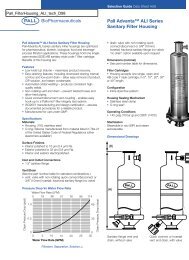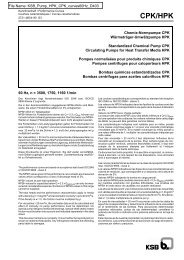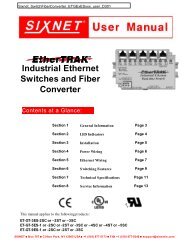Operation and Maintenance Manual for
Operation and Maintenance Manual for
Operation and Maintenance Manual for
Create successful ePaper yourself
Turn your PDF publications into a flip-book with our unique Google optimized e-Paper software.
USFilter<br />
10 Technology Drive<br />
Lowell, Massachusetts 01851<br />
Tel: (800) 875-7873 • Fax: (978) 441-6025<br />
Email:<br />
Lowell_TechSupport@USFilter.com<br />
<strong>Operation</strong> <strong>and</strong><br />
<strong>Maintenance</strong><br />
<strong>Manual</strong><br />
<strong>for</strong><br />
KFZSD<br />
KF Series<br />
Duplex Alternating<br />
Softener Systems<br />
With 1” <strong>and</strong> 1.5” Valves<br />
Catalog # _______________________<br />
Serial # ________________________<br />
68/KFZSD-030 – 01/04 Rev. 1
CAUTIONS AND WARNINGS<br />
Prior to operating or servicing this device, this manual must be read <strong>and</strong> understood. If something<br />
is not clear, call <strong>for</strong> assistance be<strong>for</strong>e proceeding. Keep this <strong>and</strong> other associated manuals <strong>for</strong><br />
future reference <strong>and</strong> <strong>for</strong> new operators or qualified service personnel.<br />
All electrical work should be per<strong>for</strong>med by a qualified electrician in accordance with the latest<br />
edition of the National Electrical Code, as well as local codes <strong>and</strong> regulations.<br />
To avoid electrical shock hazard, do not remove covers or panels when power is supplied to the<br />
device. Do not operate the device when covers or panels are removed.<br />
WARNING<br />
A faulty pump motor or wiring can be a serious shock hazard if it or<br />
surrounding water is accessible to human contact. To avoid this danger,<br />
DO NOT remove any grounding wire from the system.<br />
DISCLAIMER STATEMENT<br />
This operation <strong>and</strong> maintenance manual is intended to be used with the component manufacturer<br />
literature provided in the Appendix. These manuals should provide complete <strong>and</strong> accurate<br />
in<strong>for</strong>mation to meet your operating <strong>and</strong>/or service requirements based on the in<strong>for</strong>mation available<br />
at the time of publication. However, USFilter assumes no responsibility <strong>for</strong> the technical content of<br />
the manufacturer literature.<br />
This manual should be read fully <strong>and</strong> understood be<strong>for</strong>e installation, operation or maintenance of<br />
the system is attempted. The in<strong>for</strong>mation in this manual may not cover all operating details or<br />
variations or provide <strong>for</strong> all conditions in connection with installation, operation <strong>and</strong> maintenance.<br />
Should questions arise which are not answered specifically in this manual, contact the USFilter<br />
Technical Support Department at the phone number provided on the cover of this manual.<br />
USFilter reserves the right to make engineering refinements that may not be reflected in these<br />
manuals. The material in these manuals is <strong>for</strong> in<strong>for</strong>mational purposes <strong>and</strong> is subject to change<br />
without notice <strong>and</strong> should not be construed as a commitment by USFilter. USFilter assumes no<br />
responsibility <strong>for</strong> any errors that may appear in this document. This manual is believed to be<br />
complete <strong>and</strong> accurate at the time of publication. In no event shall USFilter be liable <strong>for</strong> incidental<br />
or consequential damages in connection with or arising from the use of this manual.<br />
©Copyright 2004 USFilter<br />
Printed in the United States of America. All rights reserved.<br />
THIS BOOK OR PARTS THEREOF MAY NOT BE REPRODUCED IN ANY FORM<br />
WITHOUT THE WRITTEN PERMISSION OF THE PUBLISHERS.
PROPRIETARY RIGHTS STATEMENT<br />
This manual discloses in<strong>for</strong>mation in which USFilter has proprietary rights. Neither receipt nor<br />
possession of this manual confers or transfers any right to the client, <strong>and</strong> by its retention hereof,<br />
the client acknowledges that it will not reproduce or cause to be reproduced, in whole or in part, any<br />
such in<strong>for</strong>mation except by written permission from USFilter. The client shall have the right to use<br />
<strong>and</strong> disclose to its employees the in<strong>for</strong>mation contained herein <strong>for</strong> the purpose of operating <strong>and</strong><br />
maintaining the USFilter equipment, <strong>and</strong> <strong>for</strong> no other purpose.<br />
In the event the content of this manual is altered or section/items are omitted during a reproduction,<br />
in whole or in part, <strong>and</strong> instructions or definitions within the reproduction result in personal injury to<br />
those who follow the altered instructions, the burden of responsibility <strong>for</strong> personal injury falls solely<br />
on the party who affects the reproduction.<br />
MANUAL USER’S GUIDE<br />
This manual describes the procedures necessary to install, operate, <strong>and</strong> maintain your USFilter<br />
Duplex Softener system. Please read this manual carefully be<strong>for</strong>e installing <strong>and</strong> operating your<br />
equipment. The equipment warranty may be voided if installation or operation instructions are not<br />
followed correctly.<br />
Warnings, Cautions, <strong>and</strong> Notes are used to attract attention to essential or critical in<strong>for</strong>mation.<br />
Warnings <strong>and</strong> Cautions will appear be<strong>for</strong>e the text associated with them, <strong>and</strong> notes can appear<br />
either be<strong>for</strong>e or after associated text.<br />
WARNING<br />
CAUTION<br />
Warnings indicate condition, practices, or procedures which must be<br />
observed to avoid personal injury or fatalities.<br />
Cautions indicate a situation that may cause damage or destruction of<br />
equipment or may pose a long term health hazard.<br />
NOTE: Notes are used to add in<strong>for</strong>mation, state exceptions, <strong>and</strong> point out areas that<br />
may be of greater interest or importance.<br />
EQUIPMENT SUPPORT<br />
USFilter continually strives to provide safe, efficient, trouble-free equipment using the optimum<br />
technology <strong>for</strong> your application. If problems should develop, USFilter’s worldwide network of<br />
technical support will be available to provide assistance. For service, sales, parts, or additional<br />
manual copies call your area representative or USFilter, Technical Support Department at the<br />
number provided on the cover of this manual.
TABLE OF CONTENTS<br />
SECTION DESCRIPTION PAGE<br />
1.0 INTRODUCTION<br />
1.1 System Function...................................................................................1-1<br />
1.2 Quality Assurance/Quality Control........................................................1-1<br />
1.3 System Part Numbers ..........................................................................1-2<br />
1.4 System Specifications ..........................................................................1-3<br />
2.0 SYSTEM INSTALLATION<br />
2.1 Equipment Included..............................................................................2-1<br />
2.2 Precautions Be<strong>for</strong>e Installation.............................................................2-4<br />
2.3 Installation of Media .............................................................................2-4<br />
2.4 Valve <strong>and</strong> Piping Installation ................................................................2-6<br />
2.5 3200NT Controller Wiring.....................................................................2-9<br />
3.0 OPERATING INSTRUCTIONS<br />
3.1 Regeneration Setup .............................................................................3-1<br />
3.2 System <strong>Operation</strong>s...............................................................................3-1<br />
3.3 Troubleshooting ...................................................................................3-1<br />
4.0 SHUTDOWN AND STORAGE<br />
4.1 Shutdown <strong>and</strong> Storage Procedure........................................................4-1<br />
5.0 SAMPLING AND TESTING<br />
5.1 General Sampling <strong>and</strong> Testing Guidelines ...........................................5-1<br />
5.2 Sampling <strong>and</strong> Testing...........................................................................5-1<br />
5.3 Resin Sampling Procedure...................................................................5-2
TABLE OF CONTENTS<br />
SECTION DESCRIPTION PAGE<br />
6.0 MAINTENANCE<br />
6.1 General <strong>Maintenance</strong> Guidelines .........................................................6-1<br />
7.0 APPENDIX<br />
7.1 Glossary of Terms................................................................................7-1<br />
7.2 Replacement / Spare Parts List............................................................7-3<br />
7.3 QA Inspection Report ...........................................................................7-3<br />
7.4 Component Manufacturer Literature.....................................................7-3
KFZSD 1”/1.5” <strong>Manual</strong> 01/04 Rev. 1 INTRODUCTION<br />
1.0 INTRODUCTION<br />
Congratulations on your selection of this water purification system. This system is designed<br />
<strong>and</strong> manufactured to the highest st<strong>and</strong>ard of quality <strong>and</strong> fully inspected prior to shipment. In<br />
order to get maximum per<strong>for</strong>mance, we ask you to read all of the following instructions be<strong>for</strong>e<br />
installing <strong>and</strong> operating this system. Any warranty offered will be void unless directions are<br />
followed exactly.<br />
This manual is divided into sections <strong>for</strong> easy reference. Review this manual thoroughly <strong>and</strong><br />
then return to section 2.0 System Installation <strong>for</strong> step-by-step installation instructions.<br />
If you need technical assistance in operating or maintaining your unit, call your local<br />
representative. If you require further assistance call the Technical Support Department at the<br />
phone number provided on the cover of this manual.<br />
1.1 SYSTEM FUNCTION<br />
The function of your water softener is to reduce the hardness in feedwater using ion<br />
exchange resin. The water softener vessel contains high quality cation resin in the<br />
sodium <strong>for</strong>m that removes hardness. Hardness will create scale on reverse osmosis<br />
membranes, water heaters, boilers, <strong>and</strong> other equipment if not removed. Calcium,<br />
magnesium, <strong>and</strong> other cations removed by the resin are replaced with sodium ions. The<br />
resin has a fixed capacity based on the pounds of salt used per cubic foot of resin<br />
during regeneration. Flow rate, TDS, <strong>and</strong> other factors will dictate the actual capacity of<br />
the resin. When the capacity is exceeded, the resin will allow the hardness ions to pass<br />
through the unit. Be<strong>for</strong>e the capacity is exceeded, the unit is removed from service <strong>and</strong><br />
regenerated with a solution of sodium chloride (brine). Completion of the regeneration<br />
steps allows the water softener to be returned to the service mode.<br />
1.2 QUALITY ASSURANCE/QUALITY CONTROL<br />
We have defined Quality Assurance <strong>and</strong> Quality Control into a series of engineering <strong>and</strong><br />
manufacturing practices <strong>and</strong> control procedures to insure that you receive the finest<br />
product available in the world. We will continue to update these practices <strong>and</strong><br />
procedures on an ongoing basis in an ef<strong>for</strong>t to improve our systems <strong>and</strong> to insure that<br />
they continue to reflect state-of-the-art technology <strong>and</strong> reliability.<br />
Quality assurance is the cornerstone of our quality program. It begins with the selection<br />
<strong>and</strong> qualification of components <strong>and</strong> materials. Be<strong>for</strong>e suppliers are selected, their<br />
products must meet or exceed rigid st<strong>and</strong>ards set by our Quality Assurance<br />
Department. From that point, our incoming material inspection insures only reliable<br />
components will be used to manufacture systems. Numerous checks are per<strong>for</strong>med as<br />
the system passes through the manufacturing process. Included with the system is a<br />
copy of the QA Data Report that includes the check that all components are included.<br />
1-1
KFZSD 1”/1.5” <strong>Manual</strong> 01/04 Rev. 1 INTRODUCTION<br />
1.3 SYSTEM PART NUMBERS<br />
Sample Part Number KFZSD 009 F P Z V A X<br />
KFZSD KF Series Duplex Softener<br />
Softener Tank<br />
Size<br />
009 9” x 40”<br />
012 12” x 52”<br />
014 14” x 65”<br />
016 16” x 65”<br />
018 18” x 65”<br />
021 21” x 62”<br />
024 24” x 72”<br />
Vessel Material<br />
F St<strong>and</strong>ard Non-Code Fiberglass<br />
Control Rating<br />
P NEMA 3R<br />
Skid<br />
Z St<strong>and</strong>-alone unit, non-skid<br />
Control Type<br />
V 3200NT w/ Volume Initiation<br />
Pipe Size<br />
A 1”<br />
B 1.5”<br />
Resin Options<br />
X St<strong>and</strong>ard Volume<br />
Note: Not all model number combinations are available.<br />
1-2
Tank<br />
Size<br />
D x H<br />
(in)<br />
KFZSD 1”/1.5” <strong>Manual</strong> 01/04 Rev. 1 INTRODUCTION<br />
1.4 SYSTEM SPECIFICATIONS<br />
Table 1-1: Duplex Softener System Specifications<br />
Pipe<br />
Size<br />
(in)<br />
6 Resin<br />
Vol.<br />
(ft 3 )<br />
Gravel<br />
Wght<br />
(lbs 1 /8”<br />
x 1 /16”)<br />
2 Capacity<br />
@ 15#/ft 3<br />
dosage<br />
(Kgr)<br />
Max. Service<br />
Flow<br />
(gpm)<br />
Backwash/<br />
Rapid<br />
Rinse<br />
Flow DLFC<br />
(gpm)<br />
Inj.<br />
Size/<br />
Color<br />
Fill<br />
Flow<br />
BLFC<br />
(gpm)<br />
3 3<br />
Cycle Times @ 15#/ft<br />
dosage<br />
(minutes)<br />
RO<br />
Pretreat<br />
St<strong>and</strong><br />
Alone<br />
BW Brine<br />
In 4,5<br />
Slow<br />
5<br />
Rinse<br />
Fast<br />
Rinse<br />
Brine<br />
Fill 4<br />
9 x 40 1.0 1.0 none 30 3 19 2.0 1/W 0.5 10 22 30 10 12 18 x 40 350<br />
12 x 52 1.0 2.0 none 60 6 21 3.5 2/B 0.5 10 32 32 10 24 18 x 40 350<br />
12 x 52 1.5 2.0 none 60 6 39 3.5 2/B 0.5 10 32 32 10 24 18 x 40 350<br />
14 x 65 1.0 3.0 40 90 9 22 5.0 3/Y 0.5 10 26 46 10 32 24 x 50 700<br />
14 x 65 1.5 3.0 40 90 9 42 5.0 3/Y 0.5 10 26 46 10 32 24 x 50 700<br />
16 x 65 1.0 4.0 55 120 12 23 7.0 3/Y 0.5 10 34 58 10 44 24 x 50 700<br />
16 x 65 1.5 4.0 55 120 12 46 7.0 3/Y 0.5 10 34 58 10 44 24 x 50 700<br />
18 x 65 1.5 5.0 75 150 15 54 9.0 3C/Y 2.0 10 26 64 10 16 24 x 50 700<br />
21 x 62 1.5 7.0 100 210 21 52 12.0 4C/G 2.0 10 16 48 10 18 24 x 50 700<br />
24 x 72 1.5 10.0 175 300 30 68 15.0 5C/W 2.0 10 26 54 10 26 24 x 50 1,000<br />
Brine<br />
Tank<br />
D x H<br />
(in)<br />
1<br />
At higher salt dosages, the softener will treat more water between regenerations, create less overall waste, <strong>and</strong><br />
produce lower-hardness effluent. At lower salt dosages, the softener will use less overall salt. For dosages<br />
below 9 #/ft 3 , consult Technical Support at the number on this manual’s front cover.<br />
2 3<br />
For other salt dosages, use the <strong>for</strong>mula: Kgr capacity = (#(30 - #) + 16) / 8 x ft resin, where # = salt dosage in<br />
lbs/ft 3<br />
3<br />
The Brine In <strong>and</strong> Slow Rinse times are set on each valve timer as a single cycle time, which is the two cycle times<br />
added together.<br />
4<br />
For other salt dosages, adjust the Brine In <strong>and</strong> Brine Tank Fill times using this <strong>for</strong>mula: Cycle time = Time shown x<br />
Salt Dosage ÷ 15.<br />
5<br />
For an inlet pressure other than 35 psig, adjust the Brine In <strong>and</strong> Slow Rinse times using the graphs in Section 8.4<br />
<strong>and</strong> this <strong>for</strong>mula: Cycle time = Time shown x Flow at 35 psig ÷ Flow at actual psig.<br />
6<br />
For tank sizes that are listed with more than one possible resin amount, refer to the last letter of the model # (see<br />
above) to determine whether to use the minimum (Y), median (X), or maximum (Z) resin volume.<br />
7<br />
At higher salt dosages, use 70% of salt instead; if more salt is loaded, the tank may overflow during the Brine Refill<br />
step.<br />
1-3<br />
Max.<br />
Salt<br />
in Tk<br />
(lbs)
KFZSD 1”/1.5” <strong>Manual</strong> 01/04 Rev. 1 SYSTEM INSTALLATION<br />
2.1 EQUIPMENT INCLUDED<br />
2.0 SYSTEM INSTALLATION<br />
Your system has been shipped to you in the following assemblies. Check to make sure<br />
that none of these appear damaged or missing.<br />
Each softener assembly consists of the following components common to all softeners<br />
(see Figure 2-1):<br />
1. (1) Fiberglass vessel with PVC riser tube distributor assembly*<br />
2. (1) Control Valve with cover*<br />
3. (1) Tank-Valve bushing (<strong>for</strong> 16” tanks with 1” valves)*<br />
4. (1) Drain line flow control (DLFC) housing<br />
5. (1) Tube fitting <strong>for</strong> brine inlet line<br />
6. (1) Kit with assorted DLFC/injector parts<br />
7. (1) Upper Disperser (1.5” valves only)<br />
8. (1) Lot Cation Resin <strong>and</strong> gravel if necessary*<br />
9. (2) Operating <strong>Manual</strong>s*<br />
10. (1) Hardness test kit<br />
5<br />
7<br />
DLFC Washers<br />
6<br />
Injector Nozzles<br />
Injector Throats<br />
Figure 2-1 Components common to all softeners<br />
* = items not shown in photos<br />
4<br />
10<br />
2-1
KFZSD 1”/1.5” <strong>Manual</strong> 01/04 Rev. 1 SYSTEM INSTALLATION<br />
The brine tank assembly included with all softeners consists of (see Figure 2-2):<br />
11. (1) Brine tank with cover<br />
12. (1) Well with cap<br />
13. (1) Salt Grid<br />
14. (1) Overflow fitting<br />
15. (1) Air check/safety valve (<strong>for</strong> 18” brine tanks)*<br />
16. (1) Air check assembly (<strong>for</strong> 24” brine tanks)<br />
17. (1) 3/8” tube elbow, fittings (<strong>for</strong> 9” – 16” systems)*<br />
18. (1) 0.5” bushing, elbow, fittings (<strong>for</strong> 18” – 24” systems)<br />
19. (2) lengths tubing with tee (<strong>for</strong> duplex 9” – 12” systems)*<br />
20. (1) length 18’ tubing with tee (<strong>for</strong> 14” – 24” systems)*<br />
21. (1) Grommet <strong>for</strong> brine line hole in tank*<br />
14<br />
18<br />
13<br />
16<br />
12<br />
11<br />
Figure 2-2: Brine Tank Components<br />
* = items not shown in photos<br />
2-2
KFZSD 1”/1.5” <strong>Manual</strong> 01/04 Rev. 1 SYSTEM INSTALLATION<br />
The following alternating kit components are also included <strong>for</strong> the duplex system:<br />
22. (1) 25’ RJ45 phone cable*<br />
23. (1) 25’ 3-wire meter cable*<br />
24. (1) cable fitting with lock nut<br />
25. (1) remote meter with bracket <strong>and</strong> tester*<br />
24<br />
Figure 2-3: Alternating Kit Components<br />
The following valve <strong>and</strong> solenoid kit components are included with the duplex system.<br />
26. (4) end connectors <strong>for</strong> actuated valves*<br />
27. (2) normally-open (NO) valves w/ mounted <strong>and</strong> tubed 24VAC solenoid valve<br />
28. (1) ¼” Union Tee*<br />
29. (1) 20’ ¼” tubing*<br />
Figure 2-4: Normally Open Diaphragm Valve w/ mounted 24VAC Solenoid (1 shown of 2)<br />
* = items not shown in photos<br />
2-3
KFZSD 1”/1.5” <strong>Manual</strong> 01/04 Rev. 1 SYSTEM INSTALLATION<br />
2.2 PRECAUTIONS BEFORE INSTALLATION<br />
NOTE: Be sure to comply with all local, state, <strong>and</strong> federal codes.<br />
A. WATER PRESSURE: The regeneration valve needs 30 psi minimum pressure to<br />
operate effectively. Softeners with 16” x 65” vessels require a minimum of 40 psi.<br />
B. WATER TEMPERATURE: Feed temperature should be 45 – 100 °F.<br />
C. INLET TURBIDITY: Maximum inlet turbidity is 5 NTU.<br />
CAUTION<br />
Water pressure is not to exceed 110 PSI, water temperature is not to<br />
exceed 100 °F, <strong>and</strong> the unit cannot be subjected to freezing<br />
temperatures.<br />
D. ELECTRICAL FACILITIES: An uninterrupted 110V alternating current (AC)<br />
electrical supply is required. Make sure the supply is always on, <strong>and</strong> cannot be<br />
turned off with another switch.<br />
E. EXISTING PLUMBING: Existing plumbing should be free from lime <strong>and</strong> iron<br />
buildup. If piping is clogged with iron, a separate iron filter unit should be installed<br />
ahead of the water softener.<br />
F. LOCATION: The softener should be located close to an open drain.<br />
G. MANUAL VALVES: Always install manual inlet, outlet, <strong>and</strong> bypass valves on the<br />
system.<br />
NOTE: If feedwater or utilities do not meet the above requirements or there is some<br />
doubt, contact your local representative or Technical Support Department at<br />
the number provided on the cover of this manual <strong>for</strong> recommendations.<br />
NOTE: Teflon tape is the only sealant to be used on any threaded fittings.<br />
2.3 INSTALLATION OF MEDIA<br />
A. Place the softener tanks on a firm foundation as close to the floor drain as<br />
possible, <strong>and</strong> level the vessels.<br />
B. A riser tube distributor assembly has been shipped in each softener vessel (see<br />
Figure 2-5. Inspect the slotted basket (bottom distributor) to be sure it is not<br />
damaged. Also make sure that the top of the riser pipe is flush with the top of the<br />
tank flange when the basket is in the middle of the tank <strong>and</strong> flat on the bottom.<br />
Cover the top of the riser pipe with tape or a plastic cap to prevent gravel <strong>and</strong> resin<br />
from getting inside the riser pipe.<br />
2-4
KFZSD 1”/1.5” <strong>Manual</strong> 01/04 Rev. 1 SYSTEM INSTALLATION<br />
Cation Resin<br />
Rise r tub e<br />
distributor<br />
assembly<br />
1/ 8” x 1/ 16” (# 4)<br />
Gravel (if applicable)<br />
Figure 2-5: Softener vessel, riser tube, <strong>and</strong> media<br />
C. Fill the tank about ¼ full with water. Center the riser tube distributor assembly in<br />
the top opening of the softener tank. Pour the proper quantity of 1/8” x 1/16” (#4)<br />
gravel (see section 1.4) into the softener – make or buy a large funnel to prevent<br />
the gravel from spilling. 9” <strong>and</strong> 12” vessels do not use a gravel underbed.<br />
D. Level the gravel as best as possible, making sure that all of the strainer slots are<br />
covered.<br />
E. Using the same funnel, pour the quantity of cation resin (see section 1.4) into the<br />
softener tank. Fill the tank with water <strong>and</strong> soak the resin <strong>for</strong> at least 2 hours.<br />
2-5
KFZSD 1”/1.5” <strong>Manual</strong> 01/04 Rev. 1 SYSTEM INSTALLATION<br />
2.4 VALVE AND PIPING INSTALLATION<br />
CAUTION Be<strong>for</strong>e installing the valve, remove the tape or cap from the top of the<br />
riser pipe.<br />
NOTE: During installation, refer to Table 1-1 <strong>for</strong> injector sizes <strong>and</strong> DLFC sizes.<br />
Figure 2-6: Injector Components <strong>and</strong> Assembly<br />
A. Verify the correct injector assembly is used using the following procedure <strong>and</strong><br />
referring to Figure 2-6 above. Each control valve has been configured <strong>for</strong> use with<br />
a specific diameter tank. If a smaller or larger tank is used instead, a different<br />
injector will need to be used:<br />
1. Remove the mounting bolts <strong>and</strong> lift off the cover <strong>and</strong> gasket.<br />
2. Compare the installed injector nozzle <strong>and</strong> throat to the specification table in<br />
Section 1.4. If the correct color injector is already installed, skip to step 6.<br />
3. Using a st<strong>and</strong>ard screwdriver, unscrew the installed injector nozzle from<br />
the injector body.<br />
4. Unscrew the installed injector throat from the injector body.<br />
5. Install the required injector throat <strong>and</strong> nozzle (see Table 1-1) – these are<br />
included in the supplied kit (see Figure 2-1). Screw them into the injector<br />
body until snug, but do not overtighten.<br />
2-6
KFZSD 1”/1.5” <strong>Manual</strong> 01/04 Rev. 1 SYSTEM INSTALLATION<br />
6. Reinstall the injector gasket, cover, <strong>and</strong> bolts.<br />
B. Note the required Backwash / Rapid Rinse flow DLFC in Table 1-1. Out of the bag<br />
of in line flow control (DLFC) washers, choose the one with this flow stamped on it<br />
(flows are in hundredths of a GPM; i.e. 500 = 5 GPM). Install this DLFC flow<br />
washer onto the inlet side of the supplied DLFC housing, as shown in Figure 2-7.<br />
Make sure the numbers on the washer are facing out.<br />
C. Install the DLFC housing onto the control valve’ s drain connection. Make sure<br />
that the arrow on the housing is pointing away from the valve.<br />
Figure 2-7: DLFC Washer Installation<br />
D. Use a silicone base grease to lubricate the two (2) O-rings at the base of each<br />
control valve.<br />
E. (Units with 1½” valves only) Install the supplied upper disperser to the bottom of<br />
each valve by pushing the large end of the disperser into the groove on the bottom<br />
of the valve until the disperser locks in place.<br />
F. (16” diameter tank systems with 1” valves) Thread the supplied tank-to-valve<br />
bushing into each vessel’s top opening<br />
G. Carefully thread each control valve into the opening in the top of the tank (or<br />
bushing if applicable). Make sure that the riser tube distributor assembly goes into<br />
the center opening in the base of the control valve. H<strong>and</strong> tighten only – do not use<br />
a wrench or any device to apply additional torque.<br />
CAUTION<br />
Install with<br />
numbers<br />
on this<br />
side<br />
Do NOT plug in the power cord at this time.<br />
H. Locate the brine tank between the two softeners. The brine tank location should<br />
be such that it will not interfere with access to the softener control valve or filling<br />
the brine tank with salt. The brine tank must be placed on a smooth firm<br />
foundation.<br />
I. Install the piping according to the System 7 Duplex Alternating Installation with<br />
Remote Meter, Figure 2-8. The brine draw lines from both control valves must be<br />
run to the common brine tank. Components supplied by the manufacturer are the<br />
3-way solenoid valves <strong>and</strong> the Normally Open Diaphragm valves. Follow all<br />
“Installation Instructions” in the Model 2750 or 2850 Control Valve Service <strong>Manual</strong>.<br />
2-7
KFZSD 1”/1.5” <strong>Manual</strong> 01/04 Rev. 1 SYSTEM INSTALLATION<br />
Figure 2-8: Duplex Alternating Installation with Remote Meter<br />
J. Loosely thread the supplied tubing fitting onto each valve’s brine inlet connection.<br />
K. Cut the supplied brine tubing into (3) 6’ pieces. Run one piece between the air<br />
check assembly on the brine tank to the supplied tubing tee <strong>and</strong> the other two<br />
pieces between the tee <strong>and</strong> each valve’s brine inlet connection. Refer to figure 2-<br />
9.<br />
Figure 2-9: Brine Tubing Connection<br />
L. The manufacturer recommends that drain tubing be installed connecting the<br />
overflow elbow on the side of the brine tank to an open floor drain. Do not run this<br />
2-8
KFZSD 1”/1.5” <strong>Manual</strong> 01/04 Rev. 1 SYSTEM INSTALLATION<br />
line overhead; it must be to a gravity drain. Do not make a direct connection to the<br />
floor drain.<br />
M. Install the remote meter in a horizontal portion on the common soft water line.<br />
Make sure the arrow on the meter’s brass casting is pointing the proper direction.<br />
For ease of service, a union should be installed on the meter outlet (the inlet has a<br />
built-in union).<br />
2.5 3200NT CONTROLLER WIRING<br />
A. Trans<strong>for</strong>mer Wiring<br />
Refer to the 3200NT Timer Service <strong>Manual</strong> “Trans<strong>for</strong>mer Installation” <strong>and</strong><br />
“2750/2850/3150 Timer Wiring Diagram.” These can be found in the 3200NT<br />
manual Table of Contents. The 3200NT Timer is supplied with a 120VAC to<br />
24VAC trans<strong>for</strong>mer that requires wiring into the 3200NT PCB. The trans<strong>for</strong>mer is<br />
wired into “P1” of the 3200NT PCB, <strong>and</strong> grounded on the chassis of the 3200NT<br />
assembly.<br />
B. Solenoid Valve Wiring<br />
Refer to the 3200NT Timer Service <strong>Manual</strong> “2750/2850/3150 Timer Wiring<br />
Diagram.” A 3-Way Universal 24VAC solenoid valve is supplied <strong>for</strong> control of the<br />
effluent product valve that is utilized in the system. The solenoid valve is wired into<br />
the 3200NT Timer PCB at terminal “P6”.<br />
C. Solenoid Valve Piping<br />
The supplied Asco 24VAC Universal Solenoid valve is pre-mounted <strong>and</strong> tubed to<br />
the diaphragm valve. The valve utilizes line pressure to open <strong>and</strong> close the valve.<br />
No further assembly is required after it is wired to the 3200NT PCB.<br />
D. Duplex, Triplex, <strong>and</strong> Quadplex Network Configuration Wiring<br />
The st<strong>and</strong>ard systems are duplex alternating systems. They can be exp<strong>and</strong>ed in<br />
the future to be triplex or quadplex operating. The 3200NT Timer has the<br />
capability to be wired <strong>and</strong> programmed to operate as a duplex, triplex, or quadplex<br />
system via a 6-place, 4-conductor RJ5 telephone cable.<br />
Refer to the 3200NT Timer Service manual “Network Timer System Configuration<br />
Wiring Diagrams” <strong>for</strong> the RJ5 cable termination schematics.<br />
E. Duplex, Triplex, <strong>and</strong> Quadplex Network Programming<br />
1. Refer to the 3200NT Timer Service <strong>Manual</strong> “Master Programming Mode<br />
Flow Chart” (yellow supplement sheets) <strong>for</strong> programming instructions <strong>for</strong><br />
the 3200NT. In addition, refer to the Equipment Specification table in<br />
Section 1.4 of this manual <strong>for</strong> the programming parameters specific to your<br />
softener.<br />
2. The system utilizes the “System 7” programming system type.<br />
3. 4 Cycle Steps are utilized during operation of the 3200NT controlled duplex<br />
softeners. The exact values are located in section 1.4 of this manual.<br />
a. Cycle Step 1 = Backwash<br />
b. Cycle Step 2 = Brine In + Slow Rinse<br />
c. Cycle Step 3 = Fast Rinse<br />
2-9
KFZSD 1”/1.5” <strong>Manual</strong> 01/04 Rev. 1 SYSTEM INSTALLATION<br />
d. Cycle Step 4 = Brine Fill<br />
4. Refer to the 3200NT Timer Service <strong>Manual</strong> “Troubleshooting” section <strong>for</strong><br />
in<strong>for</strong>mation on any communication or programming problems.<br />
NOTE: For Duplex (or Triplex <strong>and</strong> Quadplex) applications, the “Lag” unit must be<br />
programmed prior to the “Lead” unit programming. Feed water hardness<br />
values are programmed in the “Lead” valve, as the water meter is connected to<br />
this valve.<br />
2-10
KFZSD 1”/1.5” <strong>Manual</strong> 01/04 Rev. 1 OPERATING INSTRUCTIONS<br />
3.1 REGENERATION SETUP<br />
3.0 OPERATING INSTRUCTIONS<br />
Be<strong>for</strong>e placing your softener into Service, use these steps to make sure the<br />
regeneration cycle <strong>and</strong> step times function properly.<br />
NOTE: When initiating a regeneration or stepping through to the next cycle step, it is<br />
very important to wait until all cams <strong>and</strong> pistons have stopped moving be<strong>for</strong>e<br />
stepping to the next cycle step. Moving too quickly between steps can cause<br />
the timer to get stuck in a particular cycle.<br />
A. Refer to the 3200NT Timer Service <strong>Manual</strong> “Timer <strong>Operation</strong>.” Initiate a<br />
regeneration manually <strong>and</strong> cycle through all steps.<br />
B. Briefly open the Product Valve <strong>and</strong> make sure the meter is functioning. Confirm<br />
that the Volume Remaining display is changing <strong>and</strong> that the Flow Indicator light<br />
is flashing.<br />
C. Fill the brine tank with salt to about 6” from the top. Use rock salt or pellets that<br />
contain less than 0.6% calcium <strong>and</strong> magnesium, less than 1.5% sulfate salts,<br />
less than 2.0% water-soluble impurities, <strong>and</strong> no grease, fat, or oil<br />
D. Salt replacement is not an automatic step. Operators must check the brine tank<br />
periodically to establish a salt refill schedule. Refer to Table 1-1 <strong>for</strong> the<br />
maximum salt allowable in the brine tank.<br />
3.2 SYSTEM OPERATIONS<br />
Refer to the Model 2750 (1”) or 2850 (1.5”) Control Valve Service <strong>Manual</strong> <strong>for</strong><br />
descriptions of the valve operations during all cycle steps. These descriptions are<br />
located near the beginning of the 2750 or 2850 Control Valve Service <strong>Manual</strong>, pages 4<br />
<strong>and</strong> 5.<br />
Refer to the 3200NT Timer Service <strong>Manual</strong> “System <strong>Operation</strong>s: System 7” <strong>for</strong><br />
explanation of the 3200NT Controller typical operation.<br />
3.3 TROUBLESHOOTING<br />
For communication or programming errors, refer to the 3200NT Timer Service <strong>Manual</strong><br />
“Troubleshooting” section.<br />
For general service <strong>and</strong> per<strong>for</strong>mance issues, refer to the Model 2750 or 2850 Control<br />
Valve “Service Instructions” section.<br />
3-1
KFZSD 1”/1.5” <strong>Manual</strong> 01/04 Rev. 1 SHUTDOWN AND STORAGE<br />
4.0 SHUTDOWN AND STORAGE<br />
If the system must be shut down <strong>and</strong> stored, per<strong>for</strong>m the following steps.<br />
4.1 SHUTDOWN AND STORAGE PROCEDURE<br />
A. Regenerate the unit<br />
B. When the system returns to Service, close all valves in the inlet <strong>and</strong> outlet piping.<br />
C. Disconnect the power to the controller.<br />
D. Once each week, open the inlet valve <strong>and</strong> put the unit into Rapid Rinse <strong>for</strong> 10 minutes;<br />
power must be restored to do this. Once complete, repeat steps B <strong>and</strong> C.<br />
E. When the softener is returned to Service, re-open the inlet <strong>and</strong> outlet valves, restore<br />
power to the controller, <strong>and</strong> regenerate the unit again<br />
4-1
KFZSD 1”/1.5” <strong>Manual</strong> 01/04 Rev. 1 SAMPLING AND TESTING<br />
5.0 SAMPLING AND TESTING<br />
This section covers sampling <strong>and</strong> testing procedures that may apply to your softener.<br />
Selected sampling <strong>and</strong> testing procedures should be per<strong>for</strong>med regularly during the operation<br />
of this system. A well kept logbook of test dates <strong>and</strong> results <strong>and</strong> of operator observations is an<br />
invaluable tool <strong>for</strong> troubleshooting future per<strong>for</strong>mance problems. Any tests used with this<br />
system must be per<strong>for</strong>med on a regular basis <strong>and</strong> must be accurately recorded in a logbook.<br />
The frequency of sampling <strong>and</strong> testing is normally at the discretion of the customer.<br />
5.1 GENERAL SAMPLING AND TESTING GUIDELINES<br />
A. Regular <strong>and</strong> complete record keeping is critical to maintaining proper operation<br />
of a softener.<br />
B. Close monitoring of per<strong>for</strong>mance will allow operators to detect operating<br />
problems early.<br />
C. The most important operating data is generated during the initial operation of<br />
new equipment. This point <strong>for</strong>ms a baseline that is used to evaluate all future<br />
operation.<br />
D. Always record a complete set of data immediately be<strong>for</strong>e <strong>and</strong> after per<strong>for</strong>ming a<br />
regeneration.<br />
E. Refer to the remainder of this section <strong>for</strong> recommended sampling procedures.<br />
5.2 SAMPLING AND TESTING<br />
Hardness is the measurement of calcium <strong>and</strong> magnesium, which are dissolved minerals<br />
that have only limited solubility in water <strong>and</strong>, there<strong>for</strong>e, frequently precipitate as scale on<br />
piping, water heaters, etc. Your softener contains a material known as resin, which<br />
removes these hardness minerals from the water.<br />
The amount of hardness in the feed water will determine the number of gallons a water<br />
softener can treat between regenerations.<br />
If the feed water hardness changes, the length of the service runs must be changed to<br />
avoid overrunning the unit or wasting water <strong>and</strong> salt on excessive regenerations.<br />
The amount of hardness in the product water is typically used as an endpoint <strong>for</strong> service<br />
runs. When the amount of hardness in the product rises to a setpoint, the resin is<br />
exhausted <strong>and</strong> must be regenerated with a salt solution (brine).<br />
The proper quantity of brine must be present in the storage tank prior to a regeneration.<br />
Refer to the Specifications Sheet in Section 1 <strong>for</strong> the required quantity.<br />
Your softener system includes a hardness testing kit. Use this kit <strong>and</strong> the included<br />
instructions to periodically check the hardness of the softener feed <strong>and</strong> product streams.<br />
5-1
KFZSD 1”/1.5” <strong>Manual</strong> 01/04 Rev. 1 SAMPLING AND TESTING<br />
5.3 RESIN SAMPLING PROCEDURE<br />
The material inside your softener - called resin - should give you years of soft water,<br />
provided your softener is operated within the guidelines given in this manual. Over the<br />
years, the resin will gradually lose its capacity to remove hardness <strong>and</strong> will eventually<br />
require replacement. To determine resin capacity, or solve any of the resin-related<br />
problems identified while troubleshooting, the resin will have to be sampled <strong>and</strong> tested<br />
using the following procedures.<br />
NOTE: Be<strong>for</strong>e starting this procedure, obtain two replacement o-rings to put between<br />
each tank <strong>and</strong> its valve. These are listed in the spare parts section.<br />
A. Disconnect the power <strong>and</strong> interconnecting wiring to the valve timer.<br />
B. Open the valve in the bypass line, then close the valves at the softener inlet <strong>and</strong><br />
outlet.<br />
C. Relieve water pressure in the softener by putting the control into regeneration<br />
<strong>and</strong> advancing through each regeneration step (waiting each time <strong>for</strong> the valve<br />
to stop moving) until the control is back in Service (see section 3.3).<br />
D. Disconnect the inlet, outlet, drain, <strong>and</strong> brine piping/tubing at the valve.<br />
E. Spin the whole brine valve <strong>and</strong> timer assembly off of the softener vessel’s top<br />
flange. Discard the two O-rings between the valve <strong>and</strong> the tank.<br />
F. To provide the most accurate in<strong>for</strong>mation on resin condition, a resin sample must<br />
be representative of the entire bed. Use a "grain thief" or related device to take<br />
a core sample of the resin bed (refer to Figure 5-1).<br />
NOTE: Do not take a sample by taking resin from only the top of the bed. The<br />
particulates <strong>and</strong> resin that normally collect at the top of the bed will not<br />
accurately represent the entire bed.<br />
1. Insert a clean ¼” pipe into the softener vessel <strong>and</strong> twist it all of the way<br />
down to the bottom of the resin bed.<br />
2. Plug the top end of the pipe <strong>and</strong> slowly lift it out of the vessel. Empty the<br />
plug of resin inside the pipe into a clean container.<br />
3. Take enough resin from the bed to fill a one quart jar, <strong>and</strong> contact your<br />
dealer to have the sample tested.<br />
G. Apply silicone lubricant to the top edge of the riser tube distributor assembly <strong>and</strong><br />
to two new O-rings. Reverse steps 1 - 5 to put the softener back into operation.<br />
5-2
KFZSD 1”/1.5” <strong>Manual</strong> 01/04 Rev. 1 SAMPLING AND TESTING<br />
¼” pipe<br />
(grain thief)<br />
Softener resin<br />
Rise r tu b e<br />
d istributo r a ssy<br />
Figure 5-1: Grain thief <strong>for</strong> resin sampling<br />
5-3
KFZSD 1”/1.5” <strong>Manual</strong> 01/04 Rev. 1 MAINTENANCE<br />
6.0 MAINTENANCE<br />
6.1 GENERAL MAINTENANCE GUIDELINES<br />
A. MAINTENANCE AND SAFETY<br />
Be<strong>for</strong>e working on this system, operators must be familiar with the General Safety<br />
Precautions at the beginning of this manual.<br />
B. VESSELS<br />
The vessel <strong>for</strong> this system is fiberglass <strong>and</strong> requires no maintenance.<br />
If exposed to freezing temperatures, the vessel <strong>and</strong> its piping must be insulated <strong>and</strong><br />
heated, or shut down <strong>and</strong> drained.<br />
C. PIPING<br />
Operators should check all piping connections periodically <strong>for</strong> leaks. Any flanges used<br />
on the piping may require periodic tightening to prevent leaks.<br />
If the system is operated within the temperature <strong>and</strong> pressure limits, little maintenance is<br />
required<br />
D. MANUAL VALVES<br />
<strong>Manual</strong> valves should be operated through their full range, at least every 6 months, to<br />
assure they function properly <strong>and</strong> are free of debris.<br />
E. PRESSURE REGULATORS<br />
Any pressure regulators used in conjunction with this system should be inspected<br />
occasionally to assure they are set properly.<br />
F. LEAK CHECKING<br />
Operators should be alert <strong>for</strong> leaking pipes, valves, <strong>and</strong> components. Detecting <strong>and</strong><br />
repairing a leak while it is still small may prevent lengthy downtime later.<br />
6-1
KFZSD 1”/1.5” <strong>Manual</strong> 01/04 Rev. 1 APPENDIX<br />
7.1 GLOSSARY OF TERMS<br />
7.0 APPENDIX<br />
The terms commonly used in softening <strong>and</strong> filtration are defined below:<br />
BACKWASH: The counter-current flow of water through a resin bed (i.e. in at the<br />
bottom of the vessel, out at the top) to clean <strong>and</strong> reclassify the bed after<br />
exhaustion.<br />
BED EXPANSION: The effect produced during backwashing: the resin particles become<br />
separated <strong>and</strong> rise in the column. The expansion of the bed due to the<br />
increase in space between resin particles may be controlled by regulating<br />
backwash flow.<br />
BED: The resin contained in a vessel.<br />
BRINE: Water saturated with salt.<br />
CAPACITY: The ability of the resin to remove hardness, measured in kilograins per<br />
cubic foot.<br />
CONCENTRATION: The amount of substance in weight, moles, or equivalents contained in a<br />
unit volume.<br />
CONTAMINANT: Any <strong>for</strong>eign component present in another substance; e.g., anything in<br />
water that is not H20 is a contaminant.<br />
CYCLE: A complete sequence of operation. For instance, a complete softener<br />
cycle of would involve: Service, Backwash, Brine In / Slow Rinse, Fast<br />
Rinse, Brine Tank Refill, <strong>and</strong> back into Service.<br />
EFFLUENT: The solution which emerges from a system unit.<br />
EXHAUSTION: The state in which the resin is no longer capable of removing enough<br />
hardness from the feed water.<br />
FINES: Extremely small particles of ion-exchange resin.<br />
FLOW RATE: The volume of solution which passes through a system within a given<br />
time. Flow rate is usually expressed in terms of gallons per minute.<br />
FREEBOARD: The space provided above the resin bed in an ion-exchange column to<br />
allow <strong>for</strong> expansion of the bed during backwash.<br />
GRAINS/GALLON: An expression of concentration of material in solution. One grain per<br />
gallon is equivalent to 17.12 parts per million.<br />
GRAIN: A unit of weight; 0.0648 grams; 0.000143 pounds.<br />
7-1
KFZSD 1”/1.5” <strong>Manual</strong> 01/04 Rev. 1 APPENDIX<br />
HARDNESS: The scale-<strong>for</strong>ming <strong>and</strong> lather-inhibiting qualities which water, high in<br />
calcium <strong>and</strong> magnesium ions, possesses.<br />
INFLUENT: The solution which enters a system unit.<br />
ION EXCHANGE: A process by which certain undesired ions of given charge are removed<br />
from solution with an absorbent, being replaced in the solution by<br />
desirable ions of similar charge from the absorbent.<br />
ION: Any particle of less than colloidal size possessing either positive or<br />
negative electric charge.<br />
KILOGRAIN: A unit of weight; one thous<strong>and</strong> grains. There are seven kilograins per<br />
pound.<br />
MEDIA: The material (resin, carbon, quartz) that is used in a fluid-treatment<br />
vessel.<br />
MINERAL: A natural inorganic substance having a definite chemical composition <strong>and</strong><br />
structure.<br />
RAW WATER: Untreated water from wells or from surface sources.<br />
REGENERATION: The process by which a system is conditioned to ready it <strong>for</strong> another<br />
service cycle.<br />
RESIN: Typically, a synthetic plastic bead with attached ions that will exchange<br />
(trade places with) with other ions in a process feed stream. Used in ionexchange<br />
applications.<br />
RINSE: The final step in a unit regeneration, in which water is flushed through the<br />
unit until the effluent quality is proper.<br />
SCALE: The precipitate that <strong>for</strong>ms on surfaces in contact with water.<br />
SOFTENING: The removal of hardness - calcium <strong>and</strong> magnesium - from water.<br />
SPECIFIC GRAVITY: The ratio of the mass of a body to the mass of an equal volume of water<br />
at 4 o C or other specified temperature.<br />
TDS: Total Dissolved Solids, in parts per million (ppm.<br />
THROUGHPUT The amount of solution passed through an exchange bed be<strong>for</strong>e<br />
VOLUME: exhaustion of the resin occurs.<br />
7-2
KFZSD 1”/1.5” <strong>Manual</strong> 01/04 Rev. 1 APPENDIX<br />
7.2 REPLACEMENT/SPARE PARTS LIST<br />
PART NUMBER DESCRIPTION<br />
05/900005977NT 1” 2750 Valve head with 1600 injector <strong>and</strong> 3200NT Timer<br />
05/900005987NT 1.5” 2850 Valve head with 1600 injector <strong>and</strong> 3200NT Timer<br />
05/900005988NT 1.5” 2850 Valve head with 1700 injector <strong>and</strong> 3200NT Timer<br />
21/132102728 Flowmeter, 1” Brass<br />
21/132102729 Flowmeter, 1.5” Brass<br />
18/903001513 Injector Conversion Kit – 1600 injector<br />
18/903001516 Injector Conversion Kit – 1700 injector<br />
05/03993-16 1” Diaphragm Valve w/ mounted <strong>and</strong> tubed 24VAC solenoid<br />
05/02561-16 1” Union/SOC Adapters <strong>for</strong> Diaphragm Valve (qty 2)<br />
05/03993-18 1.5” Diaphragm Valve w/ mounted <strong>and</strong> tubed 24VAC solenoid<br />
05/30476-18 1.5” Union/SOC Adapters <strong>for</strong> Diaphragm Valve (qty 2)<br />
B10011249<br />
O-ring, 2750 Valve Distributor Base (Fleck PN 11710, refer to page 8,<br />
(part of o-ring kit)<br />
item 19 in 2750 Control Valve <strong>Manual</strong>)<br />
B10011248<br />
O-ring, 2750 Valve Base (Fleck PN 11208, refer to page 8, item 20 in<br />
(part of o-ring kit)<br />
2750 Control Valve <strong>Manual</strong>)<br />
B10011247<br />
O-ring, Top of Tank, <strong>for</strong> 2750 Valves (Fleck PN 10381, refer to page 8<br />
(part of o-ring kit)<br />
item 22 in 2750 Control Valve <strong>Manual</strong>)<br />
B10008143<br />
O-ring, Top of Tank, <strong>for</strong> 2850 Valves (Fleck PN 16455, refer to page 6<br />
(part of o-ring kit)<br />
item 15 in 2850 Control Valve <strong>Manual</strong>)<br />
B10008642<br />
O-ring, 2850 Valve (Fleck PN 13577, refer to page 6 item 16 in 2850<br />
(part of o-ring kit)<br />
Control Valve <strong>Manual</strong><br />
7.3 QA INSPECTION REPORT<br />
The QA Component Inspection Report will follow the manual.<br />
7.4 COMPONENT MANUFACTURER LITERATURE<br />
The vendor literature <strong>for</strong> your Duplex Softener will follow this manual.<br />
Component Manufacturer Manufacturer<br />
Model Number<br />
1” Control Valve Fleck 2750<br />
1.5” Control Valve Fleck 2850<br />
Network Controller Fleck 3200NT<br />
7-3
For Product <strong>and</strong> Service In<strong>for</strong>mation<br />
USFilter<br />
10 Technology Drive<br />
Lowell, MA 01851<br />
Telephone: (978) 934-9349<br />
FAX: (978) 441-6025<br />
For Technical Support<br />
Telephone: (800) 875-7873 Extension 5000<br />
Email: Lowell_TechSupport@USFilter.com



